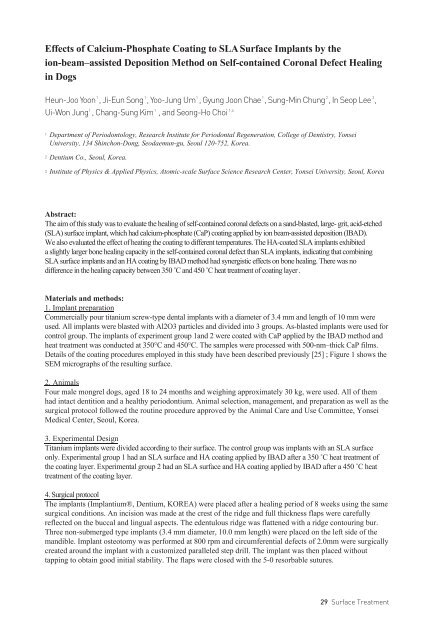Documentation Summaries - Implantium & Medical Company
Documentation Summaries - Implantium & Medical Company
Documentation Summaries - Implantium & Medical Company
Create successful ePaper yourself
Turn your PDF publications into a flip-book with our unique Google optimized e-Paper software.
Effects of Calcium-Phosphate Coating to SLA Surface Implants by the<br />
ion-beam–assisted Deposition Method on Self-contained Coronal Defect Healing<br />
in Dogs<br />
1 1 1 1 2 3<br />
Heun-Joo Yoon , Ji-Eun Song , Yoo-Jung Um , Gyung Joon Chae , Sung-Min Chung , In Seop Lee ,<br />
1 1 1,4<br />
Ui-Won Jung , Chang-Sung Kim , and Seong-Ho Choi<br />
1<br />
2<br />
3<br />
Department of Periodontology, Research Institute for Periodontal Regeneration, College of Dentistry, Yonsei<br />
University, 134 Shinchon-Dong, Seodaemun-gu, Seoul 120-752, Korea.<br />
Dentium Co., Seoul, Korea.<br />
Institute of Physics & Applied Physics, Atomic-scale Surface Science Research Center, Yonsei University, Seoul, Korea<br />
Abstract:<br />
The aim of this study was to evaluate the healing of self-contained coronal defects on a sand-blasted, large- grit, acid-etched<br />
(SLA) surface implant, which had calcium-phosphate (CaP) coating applied by ion beam-assisted deposition (IBAD).<br />
We also evaluated the effect of heating the coating to different temperatures. The HA-coated SLA implants exhibited<br />
a slightly larger bone healing capacity in the self-contained coronal defect than SLA implants, indicating that combining<br />
SLA surface implants and an HA coating by IBAD method had synergistic effects on bone healing. There was no<br />
difference in the healing capacity between 350 ˚C and 450 ˚C heat treatment of coating layer .<br />
Materials and methods:<br />
1. Implant preparation<br />
Commercially pour titanium screw-type dental implants with a diameter of 3.4 mm and length of 10 mm were<br />
used. All implants were blasted with Al2O3 particles and divided into 3 groups. As-blasted implants were used for<br />
control group. The implants of experiment group 1and 2 were coated with CaP applied by the IBAD method and<br />
heat treatment was conducted at 350°C and 450°C. The samples were processed with 500-nm–thick CaP films.<br />
Details of the coating procedures employed in this study have been described previously [25] ; Figure 1 shows the<br />
SEM micrographs of the resulting surface.<br />
2. Animals<br />
Four male mongrel dogs, aged 18 to 24 months and weighing approximately 30 kg, were used. All of them<br />
had intact dentition and a healthy periodontium. Animal selection, management, and preparation as well as the<br />
surgical protocol followed the routine procedure approved by the Animal Care and Use Committee, Yonsei<br />
<strong>Medical</strong> Center, Seoul, Korea.<br />
3. Experimental Design<br />
Titanium implants were divided according to their surface. The control group was implants with an SLA surface<br />
only. Experimental group 1 had an SLA surface and HA coating applied by IBAD after a 350 ˚C heat treatment of<br />
the coating layer. Experimental group 2 had an SLA surface and HA coating applied by IBAD after a 450 ˚C heat<br />
treatment of the coating layer.<br />
4. Surgical protocol<br />
The implants (<strong>Implantium</strong>®, Dentium, KOREA) were placed after a healing period of 8 weeks using the same<br />
surgical conditions. An incision was made at the crest of the ridge and full thickness flaps were carefully<br />
reflected on the buccal and lingual aspects. The edentulous ridge was flattened with a ridge contouring bur.<br />
Three non-submerged type implants (3.4 mm diameter, 10.0 mm length) were placed on the left side of the<br />
mandible. Implant osteotomy was performed at 800 rpm and circumferential defects of 2.0mm were surgically<br />
created around the implant with a customized paralleled step drill. The implant was then placed without<br />
tapping to obtain good initial stability. The flaps were closed with the 5-0 resorbable sutures.<br />
29 Surface Treatment


